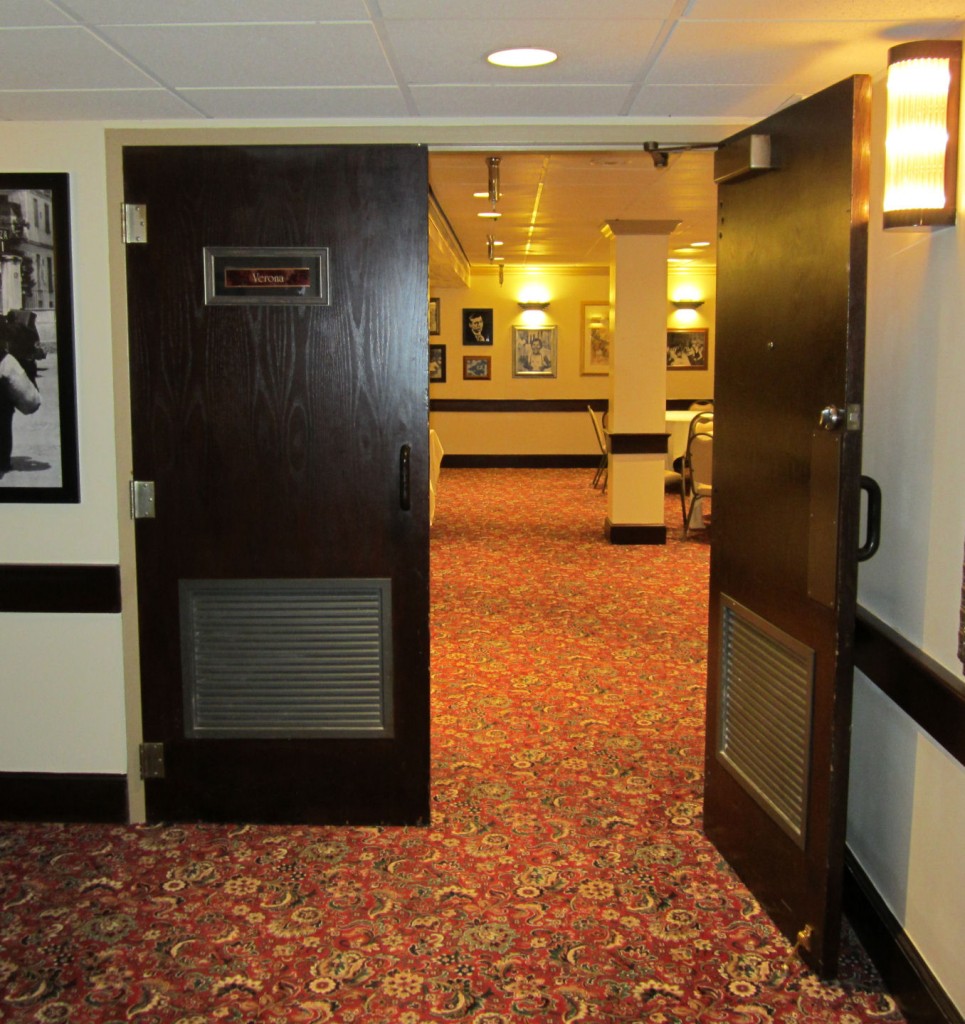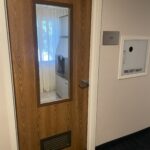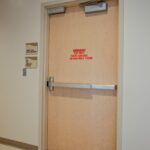 Last week I posted some photos of a pair of 20-minute doors with some “issues,” and I want to thank everyone who left comments with their thoughts on the situation. Often, people tell me that they know something is required but aren’t sure where to find it written, so I thought it would be good to follow up on what the issues were and why, as well as addressing some of the comments.
Last week I posted some photos of a pair of 20-minute doors with some “issues,” and I want to thank everyone who left comments with their thoughts on the situation. Often, people tell me that they know something is required but aren’t sure where to find it written, so I thought it would be good to follow up on what the issues were and why, as well as addressing some of the comments.
Not Self-Closing – This pair has kick-down stops, and prior to the installation of those it appears that a rubber wedge was commonly used since there was one sitting on top of the closer. It’s hard to tell from the photos but the closers are equipped with friction hold-open arms as well. My guess is that someone didn’t know how to adjust them to hold open once they stopped working right, and took matters into their own hands.
Here’s where NFPA 80-2007 and 2010 state that rated doors must be self-closing (there are other mentions of this in 80 as well):
6.1.4 Operation of Doors. All swinging doors shall be closed and latched at the time of fire.
6.1.4.1 For the purposes of 6.1.4, the operation of doors shall be divided into the following categories:
(1) Self-closing doors
(2) Automatic-closing doors
(3) Power-operated fire doors
6.1.4.2 Self-Closing Doors.
6.1.4.2.1 Self-closing doors shall swing easily and freely and shall be equipped with a closing device to cause the door to close and latch each time it is opened.
6.1.4.2.2 The closing mechanism shall not have a hold-open feature.
Not Self-Latching – This pair has manual flush bolts, push plates, pulls, and a deadbolt, so the hardware does not positively latch the door when it is closed. NFPA 80 does allow manual flush bolts where permitted by the AHJ, but this is limited to rooms which are not normally occupied by humans (see below). If these doors were positive-latching, they would have to be equipped with fire exit hardware (and a door label stating that), because of the occupant load of the assembly space served by the doors.
Here’s where latching is addressed in NFPA 80 – 2007 and 2010 (again, there are other mentions of this within the standard):
6.4.4.3 All single doors and active leaves of pairs of doors shall be provided with an active latch bolt that cannot be held in a retracted position as specified in the individual manufacturer’s published listings.
6.4.4.3.1 Doors other than those used in means of egress shall be permitted to be provided with dead bolts in addition to the active latch bolts or as otherwise permitted by the AHJ.
6.4.4.3.2 Locks with dead bolts that are interconnected with latch bolts and retract when the latch bolt is retracted shall be permitted for use on fire doors within a means of egress.
6.4.4.3.3 Latching arrangements that do not provide positive latching in the normal mode shall be permitted to be used provided that, in a fire emergency, the door becomes positively latched by means of an automatic fail-safe device that is activated by an automatic fire detector. (See Section 4.7.)
6.4.4.4 Where both leaves are required for exit purposes, they shall be provided with labeled fire exit hardware.
6.4.4.4.1 Where permitted by the AHJ, pairs of doors not provided with an astragal shall be permitted to have labeled fire exit hardware and an open back strike installed on the inactive leaf, and either labeled fire exit hardware or any labeled latch capable of being opened by one obvious operation from the egress side installed on the active leaf. 6.4.4.5 Where a pair of doors is needed for the movement of equipment and where the inactive leaf of the pair of doors is not required for exit purposes, labeled, top and bottom, self latching or automatic flush bolts, or labeled two-point latches shall be permitted.
6.4.4.5.1* Manually operated, labeled, top and bottom flush mounted or surface-mounted bolts on the inactive leaf of a pair of doors shall be permitted to be used where acceptable to the AHJ, provided they do not pose a hazard to safety to life.
A.6.4.4.5.1 This provision limits their use to rooms not normally occupied by humans (e.g., transformer vaults and storage rooms).
Louvers – These doors are equipped with large louvers which will allow the transmission of smoke during a fire. They do not appear to be “automatic louvers” as defined and allowed by NFPA 80:
3.3.9 Automatic Louver. An opening in a door with a series of slats or blades to allow passage of air and designed to close automatically in the event of fire.
6.4.6 Automatic Louvers. Only labeled fire door louvers shall be used in fire doors.
NFPA 80 doesn’t clearly define whether the louvers must be closed by smoke or heat, so it seems like fusible link louvers are still allowed by NFPA 80. However, if you dig a little deeper, you’ll find that they are prohibited in most locations by the International Building Code and NFPA 101 – The Life Safety Code:
The IBC – 2009 does not allow louvers in smoke barrier doors in I-2 occupancies (710.5, Exception 1), smoke partitions (711.5.1), or door assemblies in corridors or smoke barriers (715.4.3.1). [Previous editions of the IBC contain the same requirements but the reference numbers are slightly different.]
NFPA 101 – 2009 does not allow louvers in smoke partitions (8.4.3.3) or smoke barriers (8.5.4), and various occupancy chapters contain further limitations on their use.
Damaged Door – There is an obvious repair where someone pushed on the inactive leaf while the flush bolt was engaged, and the flush bolt popped through the veneer. I think any fire door assembly inspector would tell you that this repair was not made properly, but NFPA 80 doesn’t specifically address re-gluing the veneer back on. It’s just bad because I said so. 🙂
Here’s what NFPA 80 – 2007 says about repairs (the language was changed slightly in the 2010 edition):
5.2.15 Repair of Fire Doors and Windows.
5.2.15.1 Damaged glazing material shall be replaced with labeled glazing.
5.2.15.1.1 Replacement glazing materials shall be installed in accordance with their individual listing.
5.2.15.2 Any breaks in the face covering of doors shall be repaired immediately.
5.2.15.3 Where a fire door, frame, or any part of its appurtenances is damaged to the extent that it could impair the
door’s proper emergency function, the following actions shall be performed:
(1) The fire door, frame, or any part of its appurtenances shall be repaired with parts obtained from the door’s manufacturer.
(2) The door shall be tested to ensure emergency operation and closing upon completion of the repairs.
5.2.15.4 When holes are left in a door or frame due to changes or removal of hardware or plant-ons, the holes shall be repaired by the following methods:
(1) Install steel fasteners that completely fill the holes
(2) Fill the screw or bolt holes with the same material as the door or frame
Painted Label – The door label is on the top of the door, and is legible (just dusty). The frame label has been painted and is not legible. UL permits (even encourages) the painting of labels, but the embossment must be bold enough that the label is still legible once painted. There is A LOT of information about labels on this post.
Hinges – One of the comments was regarding the use of half-surface hinges on fire doors. My 1961 copy of NFPA 80 states that hinges are attached by bolting through the door. Since I have been working in the door and hardware industry, full-mortise hinges have been the norm. I’m not sure when the change occurred – sometime between 1961 and 1986, but you may run into some thru-bolted half-surface hinges. One thing to watch out for is the creative retrofit that happens when the hinge reinforcement breaks.
The question remains…do these doors need to be fire-rated? That I don’t know. Sometimes labeled doors are installed where they aren’t required, which makes it difficult for inspectors. I would highly recommend that if a labeled door isn’t required, the label should be removed before installation.
You need to login or register to bookmark/favorite this content.






There are a few issues and I have seen hinges like this on Egress doors on exterior of buildings, YES on the outside and all I can do is think they got a blank hinge door(no hinge prep) and just mounted the hinges on the door. The auto drop down door stop is a regular on most fire doors
These doors don’t look like they are or should be rated with so many issues even in Canada
Seen a door today in a data room rated door and frame but the issue I seen was that not seen by the inspectors as the tower of the data system leg was to long, yes into the door way so the door will never close 🙂
Lori
Will you be teaching a class at Yankee this year 2015 ?
Would really like to take your class.
Jim
Hi Jim –
I’m not planning to teach at Yankee, but usually the local Allegion office teaches at least a couple of classes there. Which of my classes are you interested in? I can pass along the request. Also – my online course will be available on-demand shortly, so there will be 4 classes that you can take any time. If you click the training tab and add your name to the notification list, you’ll get an email when the on-demand classes are ready (probably June).
– Lori
I have a new construction condition that is calling for 24″x24″ return air grills (Fusible link) on a 20 min door. A description of the project is:
* 28 story highrise (Multi-Family / rentable apartments)
* All of our conditions fall into the D2 occupancy loads
* The openings occur in the corridor, at Mechanical Closets that need return air grills. They do not have wall space, so they are requesting we supply them in the door.
* I cannot find anywhere that tells me these openings are smoke barrier or smoke partitions. (a separate questions would be, how do I determine where these occur in the building?)
Is this allowed? Per the IBC and NFPA 101 codes you mention above, it appears that these doors being in a corridor, would restrict the use of a louver and/or grill (even if they are fusible link).
Hi Mike –
Typically, louvers are not allowed in fire doors that open into a means of egress. For example, here’s where this is stated in the 2015 edition of the IBC:
716.5.3 Door assemblies in corridors and smoke barriers.
716.5.3.1 Smoke and draft control. Fire door assemblies shall meet the requirements for a smoke and draft control door assembly tested in accordance with UL 1784. The air leakage rate of the door assembly shall not exceed 3.0 cubic feet per minute per square foot of door opening at 0.10 inch of water for both the ambient temperature and elevated temperature tests. Louvers shall be prohibited. Installation of smoke doors shall be in accordance with NFPA 105.
Because your doors are in a corridor, the language above would prohibit the louvers. It’s not always easy to determine whether a wall is required to be a smoke barrier or smoke partition, but it should be noted on the code plans. In this case, it’s irrelevant because these are corridor doors.
I hope this helps!
– Lori
Lori,
Thanks for the quick reply. The drawings clearly request this, so I have an RFI out (referencing applicable codes). I’m sure this will not be the last time you see my name on here
Mike Rouse
I’m happy to help any time. 🙂
– Lori
Do kick plates of a smoke door have to be UL rated?
Hi Jason –
If a door is not a fire door, I don’t know of a requirement for the kick plate to be UL listed. Even for fire doors, if the plate is within the bottom 16 inches of the door it does not have to be labeled.
– Lori
Jason, I have a 4 story Apt. Water heaters are on the roof they have HM 20 min door and frame. requesting the door have full louver. Can a fusible link be used here ? Again this is on the roof.
Maybe someone can help me find suppliers of the door core materials that is fire-rated EI2-20?
Much appreciated!
Hi Cathy –
I don’t have that information but maybe a reader will respond.
– Lori